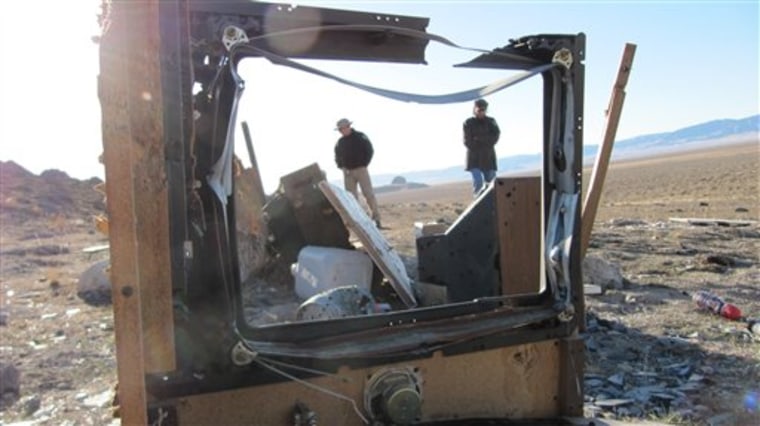During a warm spell this fall, vandals hauled 18 decrepit televisions and computers down a narrow gravel road in Utah's picturesque Skull Valley, dumped them on a hillside, blasted them with guns and left them for dead.
Nearby on the scrubby valley floor, other items have met the same fate: a hot water heater, paint cans, a candy vending machine, a couch and even a pile of mannequin heads.
Illegally dumped garbage is piling up on federal lands, often creating toxic hazards and costly cleanups. And nowhere is it more apparent than on the vast, often-stunning tracts owned by the Bureau of Land Management, the nation's largest landlord with some 412,000 square miles, mostly in 12 Western states.
"We can't keep up with it," Ray Kelsey, a BLM outdoor recreation specialist said on a recent trip to an outlaw dump site about 80 miles west of Salt Lake City. "It's happening every day."
The BLM doesn't keep a nationwide tab on the number of illegal dump sites, but hundreds of thousands of dollars are spent each year to clean them up, said Georgette Fogle, who oversees the BLM's solid waste program from Washington D.C. "Every state has a problem," Fogle said.
That includes junk from meth labs in Alaska, solvents in Idaho, tires in Wyoming, burned-out cars in Colorado and washing machines in New Mexico. BLM officials fear more TVs will be abandoned as part of the switchover from analog to digital signals.
And where one pile of garbage shows up, others follow.
"If there's trash there already, (people) feel like they can dump their own trash," said Beth Barrie, project manager for Take Pride in America in southern Nevada.
Dozens of sites outside Vegas
BLM officials there say that over the last year, they've cleaned up more than 100 illegal dumps sites outside Las Vegas. Another 100 are scheduled for cleanup and about 35 are perpetual problems that may never be remediated.
Faced with mounting dump sites and expenses, BLM is now preparing a national appeal to the public to halt illegal dumping. A nationwide campaign could launch next year.
It's no sure bet though. In many places, the BLM has put up signs asking the public not to litter. Many end up vandalized, destroyed or shot to pieces.
It's frustrating, said Kelsey, who worked on a recent cleanup that yielded more than 60 cubic yards of trash — enough to fill the beds of 20 to 30 pickup trucks — from a site in Skull Valley only to have it quickly littered again.
Dumpers tend to prefer places outside metropolitan areas with easy road access and scant law enforcement. The junk they leave behind not only fouls the landscape but can be hazardous to people and wildlife, such as the lead, mercury and other nasty substances in leaky TVs and computers.
The BLM is left having to hire a private hazardous material cleanup contractor. In Utah, BLM officials estimate they've spent more than $125,000 since 2005 to clean up dumped electronics.
Catching the litterbugs in the act however has proven difficult, with rangers being outnumbered by the illegal dumpers and charged with patrolling millions of remote acres.
Those tenacious enough to dig through piles of trash for a name or address label sometimes come up with a lead. That's how they caught a New Mexico woman who told authorities she paid a contractor to haul her garbage away and was surprised to learn it ended up on BLM land.
Scofflaws are sometimes caught and fined but it's rare. "I'd say 5 to 10 percent we can trace it back," said Linda McGlothlen at BLM's office in Colorado's Royal Gorge office.
The dumps can sometimes mirror the state of the local economy, such as in the desert outside Las Vegas.
In boom building times, there was construction waste like leftover wood, bricks and pipes. Now, it's a grimmer reality. As the economy has flagged and people have been forced out of their homes, there's been an increase in abandoned couches, toys, toilets and other household goods.
'Adopt-a-parcel' program
Barrie, of Take Pride in America, is part of a team at the University of Nevada-Las Vegas' Public Lands Institute that's working with federal agencies to find ways to curb dumping by improving stewardship and raising awareness. They've launched public ad campaigns and started an "adopt-a-parcel" program for neighbors to patrol nearby BLM land.
Successes against the dumping however have been hard-won.
One area popular with shooters outside Billings, Mont., was littered for years with discarded and bullet-ridden computers, microwaves, fire extinguishers and oil drums. Chuck Ward, a former BLM staff ranger who led efforts to clean up the site, theorizes a connection between testosterone and blowing things up. "They like to see stuff break," Ward said.
Finally fed up, BLM officials and volunteers cleaned up the site and began regular patrols, handing out tickets and driving away lawbreakers.
"The only thing I've seen work is the way we did it: a clean slate after the cleanup and a physical presence there hard and heavy for 18 to 24 months," Ward said.
